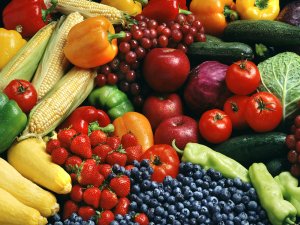We are constantly bombarded with the latest diet fads and crazes which promise to help us lose weight. Not surprisingly, there is no clear winner in the race to be the ‘best’ diet plan – no single diet will work for everyone – but most people accept that providing your body with foods rich in healthy nutrients is a good starting point.
What many people fail to consider is that your eyes are no exception to this – nutrition is an essential part of maintaining good vision into later life.
The Eye-Health Diet
A diet high in fat and cholesterol can lead to a build-up of fatty deposits in the blood vessels under the macula. This increases the risk of age-related macular degeneration (AMD). So researchers advise that people should try to eat five portions of fruit and vegetables a day, maintain a low-fat diet and eat foods rich in antioxidants
The two nutritional pigments lutein and zeaxanthin can be found naturally in a number of food sources. For example, lutein can be found in yellow peppers, mango, bilberries and green leafy vegetables such as kale, spinach, chard and broccoli. Zeaxanthin can be found in orange sweet peppers, broccoli, corn, lettuce, spinach, tangerines, oranges and eggs.
Despite nutritional advice being available, awareness of the link between diet and eye health is poor.
Nutrition of the Eye
The main nutritional components of the eye are pigments known as carotenoids. There are over 600 known carotenoids in nature. In the human eye, just three of these nutritional pigments – lutein, zeaxanthin and meso-zeaxanthin – form a concentrated ‘yellow spot’ in the macular, known as the macular pigment.
This pigment has two main functions: it acts as an antioxidant and it filters light.
As short wavelength (blue) light passes through the retina to the photoreceptors and pigmented epithelial cells, reactive oxygen species are generated. The conversion of the light energy into a nerve impulse by the photoreceptors generates free radicals – unstable molecules which damage a variety of tissues – resulting in many of the diseases and conditions associated with ageing. Antioxidants in the eye are able to quench these free radicals, thereby protecting the eye from oxidative damage. Lutein, zeaxanthin and particularly meso-zeaxanthin are very effective antioxidants.
Blue light, because of its relatively high photon energy, more readily damages the retina than yellow or red light, which is less energetic. The macular pigment acts as a filter, particularly to blue light, and therefore protects against this damaging effect.
These two functions are extremely important as they help protect against worsening of diseases of eye, such as AMD.
Superfoods for the Eye
These foods should be recommended to patients for the maintenance of good eye health:
- Nuts and berries
- Spinach, kale and green leafy vegetables
- Blueberries and grapes
- Eggs
- Cold water fish
- Papaya
- Garlic, onions and capers
- Soy
-
Virgin olive oil






